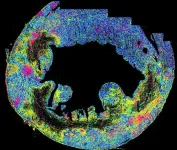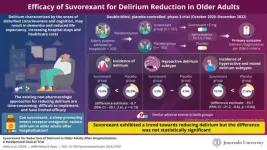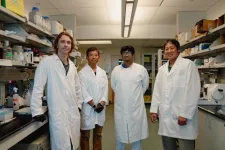(Press-News.org) Highlights:
Salmonella enterica causes disease in 1.2 million people in the U.S. annually.
The most common way people get infected is by consuming contaminated fresh produce.
New research shows that bacterial leaf spot of lettuce and high humidity promote S. enterica growth in lettuce, and climate change is predicted to increase humid periods.
Washington, D.C.—Climate change will increase the risk of the foodborne illness from Salmonella enterica, according to a new study. The research was published today in Applied and Environmental Microbiology, a journal of the American Society for Microbiology.
S. enterica causes disease in 1.2 million people in the United States every year. In recent years, the most common route of infection has been the consumption of contaminated fresh produce. Salmonella survives on multiple agricultural crops and persists in the soil for extended periods of time. On plants, researchers have found that Salmonella exploits changes to the plant environment imparted by other organisms. Plants infected with bacterial phytopathogens (organisms that cause disease in plants) result in increased persistence for this human enteric pathogen.
“It's not surprising that a host is altered by disease. What's interesting is how these changes affect other members of the bacteria community, in addition to the pathogen causing the disease. Furthermore, the impact of increased humidity on healthy plants also supported Salmonella's survival on plants, which would make climate change a food safety issue,” said corresponding study author Jeri Barak, Ph.D., a professor in the Department of Plant Pathology, University of Wisconsin-Madison. “Controlling plant disease such as bacterial leaf spot of lettuce is also important for food safety. Climate change will increase the risk of foodborne illness from consumption of raw produce.”
Bacterial leaf spot caused by Xanthomonas hortorum pv. Vitians is a common threat to leafy green production. In the new study, the researchers set out to investigate whether the fate of Salmonella is impacted by humidity or by timing of arrival during disease progress of bacterial leaf spot.
The researchers conducted experiments with lettuce with bacterial leaf spot and Salmonella. The experiments varied the days when plants were infected with X. Vitians and when S. enterica arrived in a water droplet on the leaf to mimic arrival via irrigation or splash dispersal from the ground. The researchers also varied high and low humidity periods and how many days they waited after Salmonella was introduced to measure the internal Salmonella population. These are Salmonella cells that have moved from the leaf surface to the leaf interior, where the bacteria is safe from solar UV exposure or post-harvest sanitization treatments.
The researchers found that bacterial leaf spot of lettuce caused by X. vitians can promote Salmonella survival and internalization within romaine lettuce. Salmonella's success is dependent on the timing of arrival during infection with bacterial leaf spot. If it arrives too early in bacterial leaf spot infection, the plant defense raised against the plant pathogen limits Salmonella growth and survival. Too late, and the host environment has succumbed to the plant disease which also curtails Salmonella growth and survival. High humidity exposure and the water-soaking symptom caused by X. vitians also enhance the ability of Salmonella to rapidly grow in lettuce, and climate change is predicted to increase humid periods.
###
The American Society for Microbiology is one of the largest professional societies dedicated to the life sciences and is composed of over 32,000 scientists and health practitioners. ASM's mission is to promote and advance the microbial sciences.
ASM advances the microbial sciences through conferences, publications, certifications, educational opportunities and advocacy efforts. It enhances laboratory capacity around the globe through training and resources. It provides a network for scientists in academia, industry and clinical settings. Additionally, ASM promotes a deeper understanding of the microbial sciences to diverse audiences.
END
Climate change increases foodborne illness risk from raw produce
2024-08-29
ELSE PRESS RELEASES FROM THIS DATE:
NSF Grant empowers FAU to explore Caribbean climate crisis with ethnography
2024-08-29
Transformations in the global climate system are profoundly destabilizing ecosystems across the Caribbean, with South Florida and Puerto Rico experiencing notable impacts. To address this challenge, researchers from Florida Atlantic University and the University of Puerto Rico (UPR) in Cayey, are turning to ethnography – an in-depth, immersive research method that involves observing and interviewing people in their natural settings.
FAU’s Dorothy F. Schmidt College of Arts and Letters, in collaboration with UPR Cayey, has received a $650,000 grant from ...
A bacterial defense with potential application in genome editing
2024-08-29
COLUMBUS, Ohio – Scientists who have described in a new study the step-by-step details of a bacterial defense strategy see the mechanism as a promising platform for development of a new genome-editing method.
The system involves two proteins that team up to disable plasmids, small DNA molecules that exchange genetic information among different bacterial strains. While plasmids provide evolutionary benefits, they can also be seen by host bacteria as threats.
The research team determined that one protein uses a short piece of DNA – known as a DNA guide – to ...
Labor day crowds temporarily impact local streams, research shows
2024-08-29
Crowds flocking to rivers and streams over Labor Day weekend are doing more than cooling off and having fun. They’re temporarily introducing chemicals and microscopic organisms into their local waterways, according to new research from Johns Hopkins University.
The research, published today in ACS ES&T Water, is the first holistic assessment of how recreation impacts streams. Findings also provide insight into the compounds and chemicals people are splashing around in when their favorite swimming spots are packed.
“Residue from ...
Borderzone Breakthrough: A new source of cardiac inflammation
2024-08-29
Ischemic heart disease is the most common cause of death in the world. It begins with a “heart attack”, also known as a myocardial infarction (MI), which causes part of the heart to die due to inadequate coronary blood flow. This leads to vigorous inflammation, heart wall remodeling, and heart failure.
Anti-inflammatory drugs have been surprisingly ineffective at preventing heart failure. As a consequence, they are not a routine part of post-MI care. However, it is possible that the most potent molecular and cellular inflammation targets have yet to be discovered.
In the Aug. 28, ...
New study assesses the efficacy of suvorexant in reducing delirium in older adults
2024-08-29
Delirium is a sudden onset and temporary state of disturbed consciousness or cognition, occurring due to underlying medical issues like fever or alcohol withdrawal. It is most common among older hospitalized adults aged 75 years or above, leading to increased risk of falls, dementia, low life expectancy, and high healthcare expenses.
Non-pharmacological approaches to prevent or reduce delirium are time-consuming, hard to implement, and partially effective. So, pharmacological interventions offer hope. Insomnia, a significant risk factor for delirium, could be alleviated with sleep-promoting medications. However, not all ...
Gene therapy gets a turbo boost from University of Hawaii researchers
2024-08-29
For decades, scientists have dreamt of a future where genetic diseases, such as the blood clotting disorder hemophilia, could be a thing of the past. Gene therapy, the idea of fixing faulty genes with healthy ones, has held immense promise. But a major hurdle has been finding a safe and efficient way to deliver those genes.
Now, researchers at the University of Hawaiʻi’s John A. Burns School of Medicine (JABSOM) have made a significant breakthrough in gene editing technology that could revolutionize how we treat genetic diseases. Their new method offers a faster, safer, and more efficient way to deliver healthy ...
Global timber supply threatened as climate change pushes cropland northwards
2024-08-29
Climate change will move and reduce the land suitable for growing food and timber, putting the production of these two vital resources into direct competition, a new study has found.
The sight of vineyards in Britain is becoming more common as hotter summers create increasingly suitable conditions for growing grapes. But behind this success story is a sobering one: climate change is shifting the regions of the world suitable for growing crops.
Researchers at the University of Cambridge have uncovered a looming issue: as the ...
Researchers identify basic approaches for how people recognize words
2024-08-29
University of Iowa researchers have defined how people recognize words.
In a new study with people who use cochlear implants to hear, the researchers identified three main approaches that people with or without hearing impairment use to recognize words, an essential building block for understanding spoken language. Which approach depends on the person, regardless of hearing aptitude or ability: Some wait a bit before identifying a word, while others may tussle between two or more words before deciding which word has been heard.
When a person hears a word, the brain briefly considers hundreds, if not thousands, ...
Experts call for routine measurement of lipoprotein (a) levels
2024-08-29
London, UK: Heart experts say that everyone should have their levels of lipoprotein (a) (Lp(a) measured routinely at least once in life, following research from one of the most populous EU countries, Poland, that shows how common high levels of Lp(a) are in the general population.
The findings come from several studies presented at the European Society of Cardiology (ESC) Congress taking place in London, UK, this week [1] and published in two journals: Progress in Cardiovascular Disease and Archives of Medical Sciences [2].
LP(a) is a parcel of fats (also known ...
Land-sea “tag-team” devastated ocean life millions of years ago reveal scientists
2024-08-29
Scientists have revealed how a “tag-team” between the oceans and continents millions of years ago devastated marine life – and altered the course of evolution on Earth.
Their study has unearthed a new explanation for a string of severe environmental crises, called oceanic anoxic events, which happened between 185 and 85 million years ago.
These occurred when the seas became critically depleted of dissolved oxygen.
Experts from the University of Southampton, which led the study, said these events triggered significant biological upheavals, including ...







